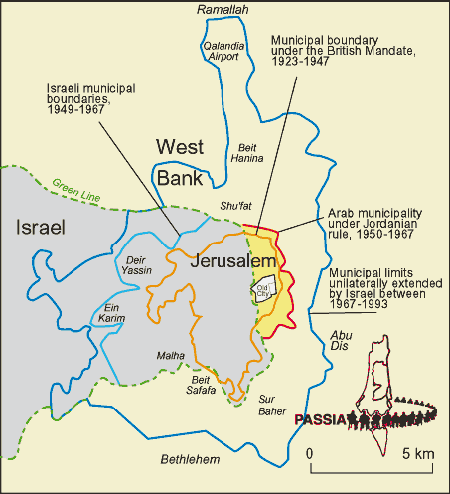UPDATE
Following a complaint from HonestReporting, The Guardian has made one correction:
This fails, however, to address the other falsehoods in the article and barely even scratches the surface as to why the implementation of a 2050 plan and the building of an airport is a virtual fiction.
There’s plenty of bias and blatant falsehoods to be found in an opinion piece by Sarah Helm in The Guardian. She speaks with Khalil Tufakji, who is described as a “65-year-old Palestinian cartographer.”
Later we find out that Helm first met Tufakji
in 1993 in Orient House, which after the signing of the Oslo accords became the Palestinian political centre in East Jerusalem. For a while Orient House buzzed, as did the Arab streets nearby, as foreign delegations rolled up, often looking at Tufakji’s maps before mulling over the shape of the new Palestinian state.

What Helm fails to disclose is that Tufakji is not simply a cartographer but was the head of the PLO’s Maps and Survey Department, which was based in Orient House. The then PLO headquarters in eastern Jerusalem was shuttered by the Israeli government in 2001 when it was found that PA security forces were operating from there illegally. Tufakji is hardly a Palestinian without an agenda.
Helm writes:
With Donald Trump now in the White House, Tufakji fears that Israel’s prime minister, Benjamin Netanyahu, will seize his chance to announce another expansion of settlements; bulldozers are ready, pink-roofed homes will be up in no time, and busloads of new immigrants – many arriving nowadays from war-torn Ukraine – will be whisked through settler roads and tunnels so fast they won’t see the Arab villages that lay claim to the land. They won’t even know they’re in a settlement.
Join the fight for Israel’s fair coverage in the news
We contacted the Jewish Agency, which handles immigration to Israel. The response is a damning indictment of Sarah Helm’s writing:
According to data from Israel’s Central Bureau of Statistics, immigrants are actually less likely than native-born Israelis to live in the West Bank. According to the CBS, in 2015 (the last year for which such data is readily available), a grand total of 880 new immigrants settled in the West Bank – 3.15% of the 27,908 who arrived that year – compared to 7,011 who went to central Israel, 5,861 who went to Tel Aviv, and 3,723 who went to Jerusalem. CBS data shows that 385,900 Israelis live in the West Bank – or, 4.48% of Israel’s the total population of 8.6 million. It thus follows that, statistically speaking, fewer immigrants to Israel choose to live in the West Bank than do other Israelis. (Incidentally, of the 6,886 immigrants who arrived in Israel from Ukraine in 2015, a grand total of 141—or, 2.04%—chose to live in the West Bank.)
Moreover, the notion that anyone is “whisking” “busloads” of immigrants to West Bank settlements is preposterous. The Jewish Agency, which is the body formally tasked with promoting and facilitating immigration to Israel from around the world, does not direct immigrants to specific places, on either side of the Green Line. Each immigrant chooses where he or she would like to reside, and each receives the same support from The Jewish Agency and the Government of Israel, regardless of his or her chosen place of residence.
Again – only 3.15% of new immigrants moved to the West Bank in 2015 – which is to say, 96.85% did not. That tells you everything you need to know.
And yet more strange unsourced “statistics” from Sarah Helm’s op-ed:
In East Jerusalem, 87% of the land is now under Israeli control “which leaves 13% for the Palestinians in East Jerusalem, down from 100% in 1967. Soon there’ll be none,” says Tufakji.
It appears that these figures have been plucked out of thin air. Even if one divides the Jerusalem municipality according to the 1967 lines, Jerusalem has never been under Palestinian control. Between 1948-67, the eastern part of the city was under Jordanian occupation.
To suggest that only 13% of what was Jordanian land is now inhabited by Palestinians is bizarre. In fact, after the city was reunited in 1967, the municipal boundaries were expanded by a significant amount (as seen by this Palestinian map below). So where do these figures come from? Neither Sarah Helm nor Khalil Tufakji provide a source.
More from Helm’s piece:
Looking further into the future, he [Tukfaji] describes Israel’s master plan for 2050 and his tone switches from despair to fear. The 2050 plan envisages a huge new airport beyond Maale Adumim on land occupied by Nebi Musa, an ancient Muslim holy site dedicated to Moses. The airport will bring hundreds of thousands of tourists and pilgrims to Jerusalem, who will stay in huge new hotel complexes connected by rail to Amman and Iraq to the east and Tel Aviv to the west. The sheer scale of the scheme is breathtaking.
In fact, there was a plan for an airport, but contrary to Tukfaji’s apocalyptic claims it was a private initiative that included a proposal for a joint airport built for both Israelis and Palestinians. Despite Tukfaji’s fears, the airport location (which isn’t on the Nebi Musa site) was actually given a green light by the Palestinian Authority which submitted its own plan for a West Bank airport in 2010. As the summary of the Israeli plan made clear:
Both Israel and the Palestinians have shared interests in the fields of transportation and economics, which strongly support the establishment of a joint airport in the Horkania Valley. Such a project will increase the economic potential for both populations and therefore create incentive for co-development and cooperation. A condition for the establishment of an airport east of Jerusalem in the foreseeable future therefore requires agreement between both parties, which can be based on this incentive, and mutual exchanges between the parties in the framework of negotiations.
Given consistent Palestinian refusals to return to the negotiating table and the fact that this proposal was never officially endorsed by the Israeli government, the prospect of such an airport being built is not currently on the cards.
More of the article is dedicated to attacking Israel’s security barrier and the claim that the Oslo Accords failed due to its allowance of continued Israeli construction in the disputed territories. Meanwhile Helm blames “extremists from both sides” for the collapse of the agreements despite the fact that Israeli actions such as the construction of the security barrier were a direct response to Palestinian terrorism.
It’s a toxic mixture when a biased writer not only promotes her own version of reality but also inserts blatantly false information courtesy of a Palestinian with a clear agenda.
At a minimum, The Guardian should take responsibility for the factual errors and issue a correction.




